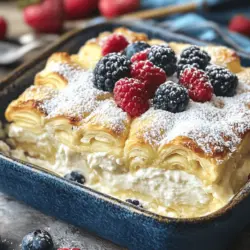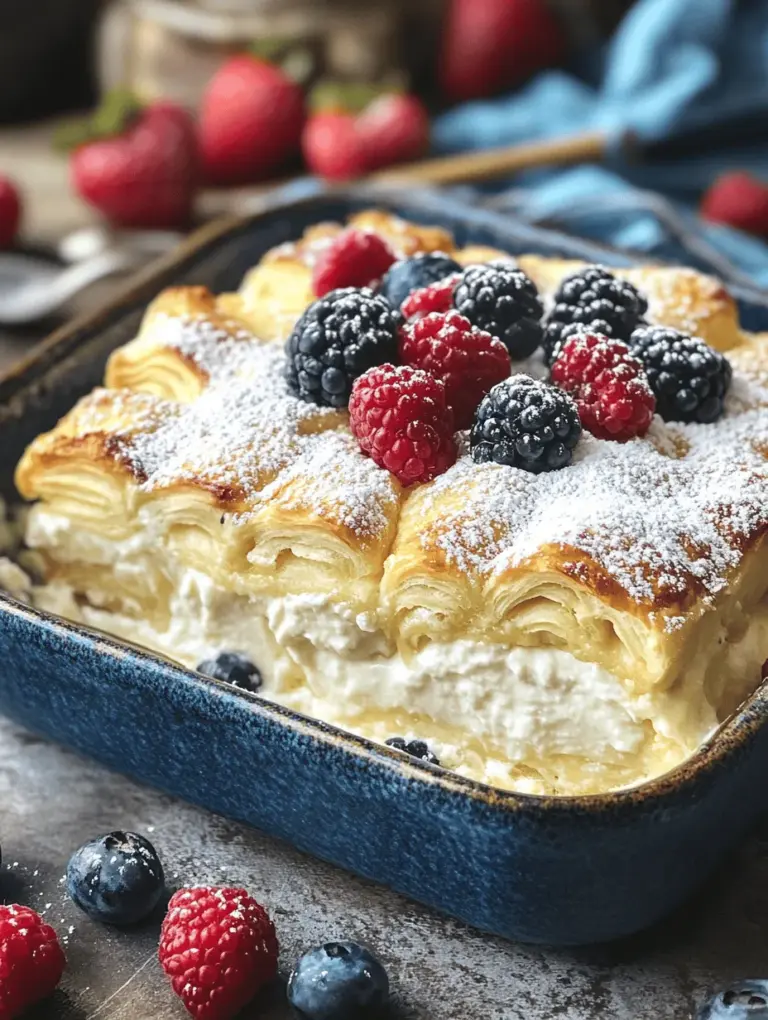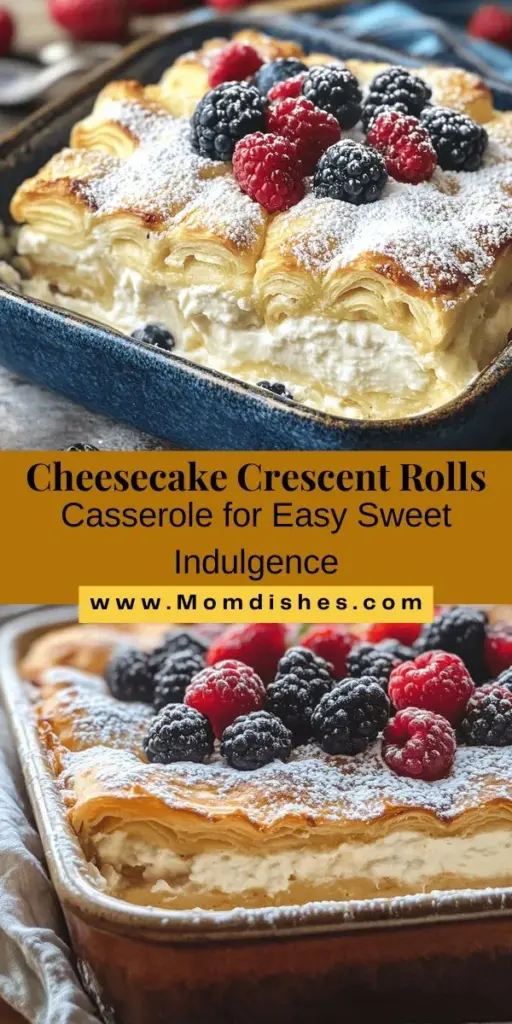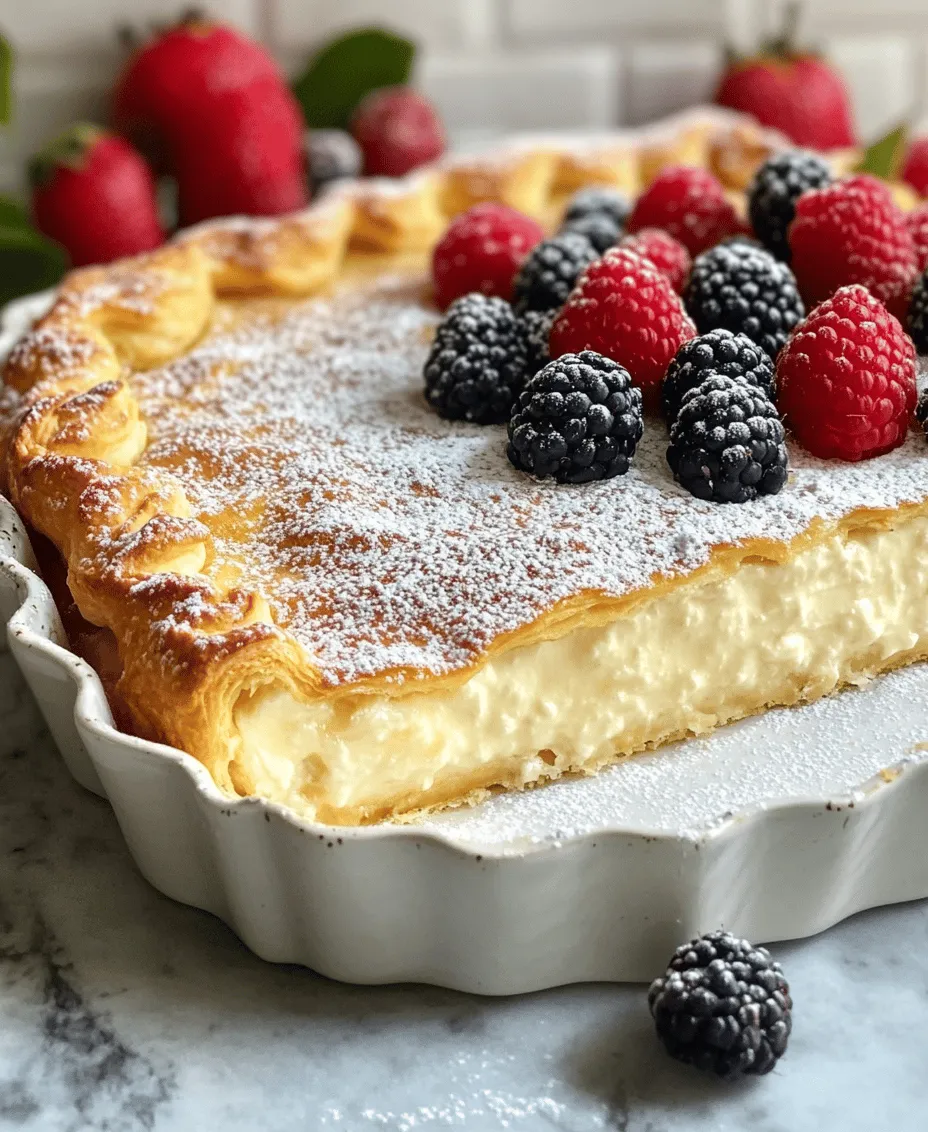Introduction
Cheesecake desserts have long held a special place in the hearts (and stomachs) of dessert lovers around the world. Their creamy texture and rich flavor make them a delightful treat for any occasion, whether it’s a birthday party, holiday gathering, or just a cozy night in. Cheesecakes can be indulgent, but they often come with a lengthy preparation process that can deter even the most enthusiastic home bakers. Enter the Cheesecake Crescent Rolls Casserole—a unique and innovative dish that combines the beloved flavors of traditional cheesecake with the convenience of crescent roll dough, all baked together in a delightful casserole format.
This recipe takes the classic elements of cheesecake—creamy filling, buttery crust, and sweet toppings—and transforms them into a simpler, quicker preparation that doesn’t skimp on flavor or presentation. Imagine cutting into a warm, gooey casserole with layers of flaky crescent rolls and a luscious cream cheese filling. It’s a dish that not only looks impressive but is also incredibly easy to make, making it perfect for both seasoned bakers and those just starting out in the kitchen.
Whether you’re hosting a brunch, celebrating a special occasion, or simply craving something sweet, this Cheesecake Crescent Rolls Casserole is sure to impress. With its simplicity and deliciousness, it’s a recipe that’s bound to become a favorite in your household.
—
Understanding the Ingredients
To achieve the best results with your Cheesecake Crescent Rolls Casserole, it’s essential to understand the role of each ingredient in the recipe. Here’s a detailed breakdown of the main components:
Crescent Roll Dough
Crescent roll dough is the star of this casserole, providing a flaky, buttery base that complements the creamy cheesecake filling. You can find crescent roll dough in the refrigerated section of most grocery stores, typically sold in tubes. Popular brands include Pillsbury and Trader Joe’s, both of which offer reliable quality.
When selecting crescent roll dough, you can choose between traditional varieties or low-fat options, depending on your dietary preferences. For the best results, make sure the dough is fresh and has not expired, as this will affect both texture and flavor.
Cream Cheese
Cream cheese is the key ingredient that gives cheesecake its rich and creamy texture. For this recipe, it’s crucial that the cream cheese is softened to room temperature before mixing. This ensures that it blends smoothly with the other ingredients, creating a velvety filling without lumps.
If you’re looking for alternatives, you can use Neufchâtel cheese for a lower-fat option or even vegan cream cheese for a dairy-free version. Keep in mind that the flavor and texture may slightly differ, but they can still yield delicious results.
Granulated Sugar vs. Powdered Sugar
In this recipe, granulated sugar is typically used for sweetening the cheesecake filling. It dissolves easily when mixed with the cream cheese, providing the perfect level of sweetness.
Powdered sugar, on the other hand, has a finer texture and is often used in frosting or glazes. While it can be substituted for granulated sugar in a pinch, it’s not ideal for this particular recipe because it can change the consistency of the filling.
Eggs
Eggs play a critical role in baking, particularly in recipes like cheesecake. They act as a binding agent, helping to hold the ingredients together, and contribute to the overall texture of the casserole. The eggs also provide stability, ensuring that the filling sets properly during baking.
For the best results, use large eggs at room temperature. This helps with even mixing and ensures that the casserole bakes uniformly.
Sour Cream
Adding sour cream to the filling enhances its flavor and creaminess, giving the cheesecake a tangy taste that balances out the sweetness. The acidity in sour cream also helps to create a smooth texture, making it a fantastic addition to the mixture.
If you’re looking for a lighter option, you can use Greek yogurt as a substitute. It will provide a similar creaminess and tang, while also boosting the protein content of the dish.
Optional Ingredients
While the base recipe is delicious on its own, you can elevate your Cheesecake Crescent Rolls Casserole by incorporating optional ingredients such as lemon zest or fresh berries.
– Lemon Zest: Adding a bit of lemon zest to the filling imparts a bright, fresh flavor that pairs beautifully with the richness of the cream cheese. It can also help to cut through the sweetness and add a lovely aroma.
– Fresh Berries: Topping the casserole with fresh berries—like strawberries, blueberries, or raspberries—adds a pop of color and flavor. The tartness of the berries complements the sweetness of the cheesecake, making each bite even more delightful.
—
Preparation Steps Explained
Now that you have a clear understanding of the ingredients, let’s walk through the preparation process step-by-step. This will guide you to create your Cheesecake Crescent Rolls Casserole seamlessly.
Step 1: Preheat Your Oven
Before you start mixing your ingredients, it’s important to preheat your oven to 350°F (175°C). Preheating ensures that your casserole bakes evenly and achieves the desired golden-brown color. It’s a crucial step that many home bakers overlook, but it can significantly impact the final outcome of your dish.
Step 2: Prepare the Cream Cheese Mixture
In a large mixing bowl, combine the softened cream cheese, granulated sugar, and sour cream. Using an electric mixer or a whisk, blend the ingredients together until smooth and creamy. This step is essential for achieving the perfect texture, so be sure to scrape down the sides of the bowl to incorporate all the ingredients thoroughly.
Once the mixture is well-combined, add in the eggs one at a time, mixing after each addition until fully incorporated. This helps to create a light and airy filling. If you’re using lemon zest, now is the time to add it in. Mix until everything is well-blended and smooth.
Step 3: Prepare the Crescent Rolls
Next, it’s time to work with the crescent roll dough. Open the tube of crescent rolls and carefully unroll the dough onto a clean surface. You’ll want to ensure that the dough is intact, as you’ll be layering it in your casserole.
If you’re using traditional crescent rolls, separate the dough into individual triangles. For a more cohesive base, you can press the seams of the triangles together to form one large sheet of dough. This will help create a uniform crust for your casserole.
Step 4: Layering the Ingredients
Once your crescent roll dough is ready, it’s time to assemble the casserole. Grease or butter a 9×13-inch baking dish to prevent sticking. Lay the crescent roll dough evenly across the bottom of the dish, pressing it down gently to create a cohesive layer.
Next, pour the cream cheese mixture over the crescent roll layer, spreading it out evenly to cover the dough. If you’re adding any optional ingredients like fresh berries, sprinkle them on top of the cream cheese filling at this stage.
Step 5: Baking the Casserole
After layering the ingredients, it’s time to bake your casserole. Place the baking dish in the preheated oven and bake for approximately 25-30 minutes, or until the top is golden brown and the filling is set. The edges should be slightly puffed, and the center should have a slight jiggle—this indicates that it’s perfectly baked.
Be sure to keep an eye on the casserole during baking to prevent over-browning. If the edges start to darken too quickly, you can loosely cover the dish with aluminum foil until the center has set.
—
With the ingredients prepared and the casserole assembled, you’re well on your way to enjoying a delicious Cheesecake Crescent Rolls Casserole. This recipe not only streamlines the cheesecake-making process but also adds a fun twist that everyone will love. Stay tuned for the next section, where we’ll explore additional baking tips and techniques to ensure your casserole comes out perfectly every time.
Best Practices for Working with Crescent Roll Dough
When preparing your Cheesecake Crescent Rolls Casserole, mastering crescent roll dough is essential to achieving the perfect texture and flavor. Here are some best practices to keep in mind:
1. Keep the Dough Cold: To ensure that the dough rolls out smoothly and maintains its flaky texture, keep the crescent roll dough refrigerated until you are ready to work with it. If it becomes too warm, it can become sticky and hard to handle.
2. Avoid Overworking the Dough: When rolling out the dough, be gentle. Overworking can lead to dense or tough crescents. Just unroll the dough, gently press the seams together if they separate, and move on to assembling your casserole.
3. Use Parchment Paper: Lining your baking dish with parchment paper can help prevent sticking and makes for easier cleanup. It also allows the bottom of the casserole to cook evenly.
4. Seal the Edges: After placing the cream cheese mixture inside, roll up the dough tightly and pinch the edges to seal. This prevents the filling from leaking out during baking.
Tips for Ensuring a Smooth Cheesecake Mixture
A creamy, smooth cheesecake mixture is key to a delicious Cheesecake Crescent Rolls Casserole. Here’s how to achieve that perfect consistency:
1. Room Temperature Ingredients: Ensure that your cream cheese, eggs, and any other refrigerated ingredients are at room temperature before mixing. Cold ingredients can lead to lumps in your cheesecake filling.
2. Mixing Order Matters: Start by beating the cream cheese until smooth before adding the sugar. This allows the sugar to dissolve properly and helps prevent graininess.
3. Avoid Overmixing: While it’s important to mix until everything is incorporated, overmixing can introduce air into the mixture, leading to cracks during baking. Mix until just combined, especially after adding the eggs.
4. Use a Hand Mixer or Stand Mixer: For the smoothest results, utilize an electric mixer rather than mixing by hand. This allows for better aeration and a creamier texture.
Importance of Cooling Time Before Slicing and Serving
Once your casserole is baked, patience is key. Allowing it to cool properly ensures the best flavor and texture. Here’s why cooling time is crucial:
1. Setting the Cheesecake: Cooling allows the cheesecake filling to firm up. Slicing too soon can result in a gooey, messy presentation, while allowing it to cool will help maintain its shape.
2. Flavor Development: As the dish cools, the flavors continue to meld together. A little waiting can enhance the overall taste of your casserole.
3. Optimal Serving Temperature: Cheesecake is best enjoyed when it’s slightly chilled. After allowing it to cool at room temperature, transfer it to the refrigerator for at least an hour before serving.
Techniques for Dusting with Powdered Sugar for Presentation
A light dusting of powdered sugar can elevate the appearance of your Cheesecake Crescent Rolls Casserole. Here’s how to do it flawlessly:
1. Use a Sifter: To avoid clumps and ensure an even distribution, use a fine mesh sieve or sifter. This will help you achieve a delicate, snow-like effect.
2. Dust Just Before Serving: For the best presentation, dust the powdered sugar right before you serve the dish. This prevents the sugar from melting or being absorbed into the cheesecake.
3. Create a Pattern: If you want to get creative, you can use stencils or cut-out shapes to dust sugar in fun patterns over the casserole, adding a unique touch to your presentation.
Flavor Variations and Customizations
This versatile recipe can be customized to suit various tastes and preferences. Here are some exciting flavor variations and customizations:
1. Add-Ins: Incorporating chocolate chips, fruit purees (like raspberry or strawberry), or chopped nuts can enhance the flavor profile. Simply fold these ingredients into the cheesecake mixture before spreading it onto the crescent rolls.
2. Alternative Toppings: Top your casserole with a dollop of whipped cream, a drizzle of chocolate or caramel sauce, or fresh fruit for a vibrant finishing touch.
3. Dietary Adjustments: For those looking for a gluten-free option, consider using gluten-free crescent roll dough. To create a lower-sugar version, substitute with a sugar alternative, ensuring that any adjustments do not compromise the overall texture of the cheesecake.
Serving Suggestions
Cheesecake Crescent Rolls Casserole is perfect for a variety of occasions. Here are some ideal serving suggestions:
1. Occasions: This dish is a delightful addition to brunch gatherings, holiday celebrations, or casual get-togethers with friends and family. Its visual appeal and delicious taste make it a standout dessert.
2. Beverage Pairings: Complement this rich dessert with beverages like a smooth cup of coffee, a refreshing herbal tea, or a sweet dessert wine. Each of these options enhances the overall dining experience.
Nutritional Information
When enjoying Cheesecake Crescent Rolls Casserole, it’s essential to consider the nutritional aspects:
1. Nutritional Overview: This recipe contains a good balance of carbohydrates from the dough, protein from the cream cheese, and fats that enhance flavor. While it is a treat, it can fit into a balanced diet when enjoyed in moderation.
2. Portion Control: A standard serving size is approximately one slice of the casserole. Be mindful of portion sizes to enjoy this dessert without overindulging, making it a suitable option for special occasions rather than everyday consumption.
Storing and Reheating
To keep your Cheesecake Crescent Rolls Casserole fresh, follow these best practices for storing leftovers:
1. Storing Leftovers: Cover any remaining casserole tightly with plastic wrap or aluminum foil, or transfer it to an airtight container. Store it in the refrigerator for up to three days to maintain freshness.
2. Reheating Tips: When reheating, preheat your oven to a low temperature (around 300°F) and cover the dish with foil to prevent drying out. Warm it for about 10-15 minutes, or until heated through. You can also enjoy it cold straight from the fridge for a refreshing treat.
Conclusion
Cheesecake Crescent Rolls Casserole is an exceptional dessert that perfectly combines the flaky goodness of crescent rolls with the creamy richness of cheesecake. Its versatility allows for countless flavor variations, making it suitable for any occasion. Whether you’re serving it at a festive brunch or enjoying a quiet evening with family, this delightful dish is sure to impress.
We encourage you to try making this easy and delicious dessert at home. With simple ingredients and straightforward steps, you can create a treat that will have everyone asking for seconds. Enjoy the experience of preparing and sharing this delightful casserole, and savor the smiles it brings to your loved ones.



